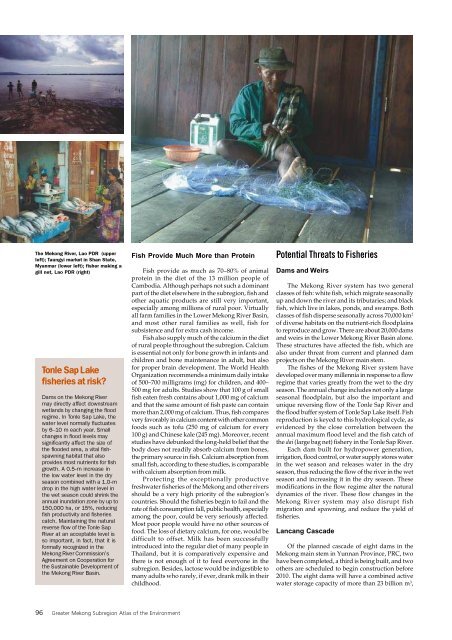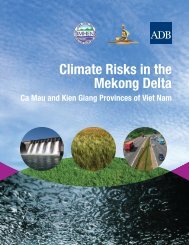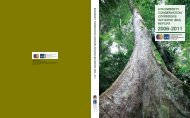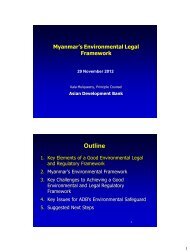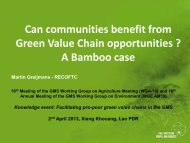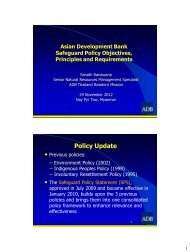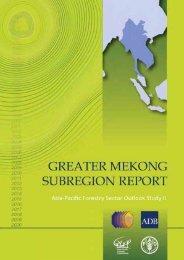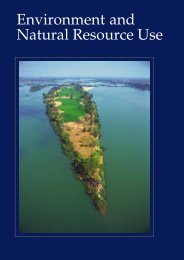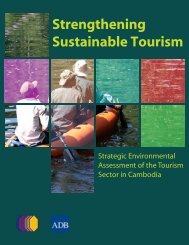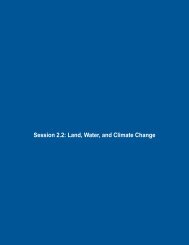You also want an ePaper? Increase the reach of your titles
YUMPU automatically turns print PDFs into web optimized ePapers that Google loves.
The Mekong River, Lao PDR (upperleft); Taungyi market in Shan State,Myanmar (lower left); fisher making agill net, Lao PDR (right)Tonle Sap Lakefisheries at risk?Dams on the Mekong Rivermay directly affect downstreamwetlands by changing the floodregime. In Tonle Sap Lake, thewater level normally fluctuatesby 6–10 m each year. Smallchanges in flood levels maysignificantly affect the size ofthe flooded area, a vital fishspawninghabitat that alsoprovides most nutrients for fishgrowth. A 0.5-m increase inthe low water level in the dryseason combined with a 1.0-mdrop in the high water level inthe wet season could shrink theannual inundation zone by up to150,000 ha, or 15%, reducingfish productivity and fisheriescatch. Maintaining the naturalreverse flow of the Tonle SapRiver at an acceptable level isso important, in fact, that it isformally recognized in theMekong River Commission’sAgreement on Cooperation forthe Sustainable Development ofthe Mekong River Basin.Fish Provide Much More than ProteinFish provide as much as 70–80% of animalprotein in the diet of the 13 million people ofCambodia. Although perhaps not such a dominantpart of the diet elsewhere in the subregion, fish andother aquatic products are still very important,especially among millions of rural poor. Virtuallyall farm families in the Lower Mekong River Basin,and most other rural families as well, fish forsubsistence and for extra cash income.Fish also supply much of the calcium in the dietof rural people throughout the subregion. Calciumis essential not only for bone growth in infants andchildren and bone maintenance in adult, but alsofor proper brain development. The World HealthOrganization recommends a minimum daily intakeof 500–700 milligrams (mg) for children, and 400–500 mg for adults. Studies show that 100 g of smallfish eaten fresh contains about 1,000 mg of calciumand that the same amount of fish paste can containmore than 2,000 mg of calcium. Thus, fish comparesvery favorably in calcium content with other commonfoods such as tofu (250 mg of calcium for every100 g) and Chinese kale (245 mg). Moreover, recentstudies have debunked the long-held belief that thebody does not readily absorb calcium from bones,the primary source in fish. Calcium absorption fromsmall fish, according to these studies, is comparablewith calcium absorption from milk.Protecting the exceptionally productivefreshwater fisheries of the Mekong and other riversshould be a very high priority of the subregion’scountries. Should the fisheries begin to fail and therate of fish consumption fall, public health, especiallyamong the poor, could be very seriously affected.Most poor people would have no other sources offood. The loss of dietary calcium, for one, would bedifficult to offset. Milk has been successfullyintroduced into the regular diet of many people inThailand, but it is comparatively expensive andthere is not enough of it to feed everyone in thesubregion. Besides, lactose would be indigestible tomany adults who rarely, if ever, drank milk in theirchildhood.Potential Threats to FisheriesDams and WeirsThe Mekong River system has two generalclasses of fish: white fish, which migrate seasonallyup and down the river and its tributaries; and blackfish, which live in lakes, ponds, and swamps. Bothclasses of fish disperse seasonally across 70,000 km 2of diverse habitats on the nutrient-rich floodplainsto reproduce and grow. There are about 20,000 damsand weirs in the Lower Mekong River Basin alone.These structures have affected the fish, which arealso under threat from current and planned damprojects on the Mekong River main stem.The fishes of the Mekong River system havedeveloped over many millennia in response to a flowregime that varies greatly from the wet to the dryseason. The annual change includes not only a largeseasonal floodplain, but also the important andunique reversing flow of the Tonle Sap River andthe flood buffer system of Tonle Sap Lake itself. Fishreproduction is keyed to this hydrological cycle, asevidenced by the close correlation between theannual maximum flood level and the fish catch ofthe dai (large bag net) fishery in the Tonle Sap River.Each dam built for hydropower generation,irrigation, flood control, or water supply stores waterin the wet season and releases water in the dryseason, thus reducing the flow of the river in the wetseason and increasing it in the dry season. Thesemodifications in the flow regime alter the naturaldynamics of the river. These flow changes in theMekong River system may also disrupt fishmigration and spawning, and reduce the yield offisheries.Lancang CascadeOf the planned cascade of eight dams in theMekong main stem in Yunnan Province, PRC, twohave been completed, a third is being built, and twoothers are scheduled to begin construction before2010. The eight dams will have a combined activewater storage capacity of more than 23 billion m 3 ,96 Greater Mekong Subregion Atlas of the Environment


